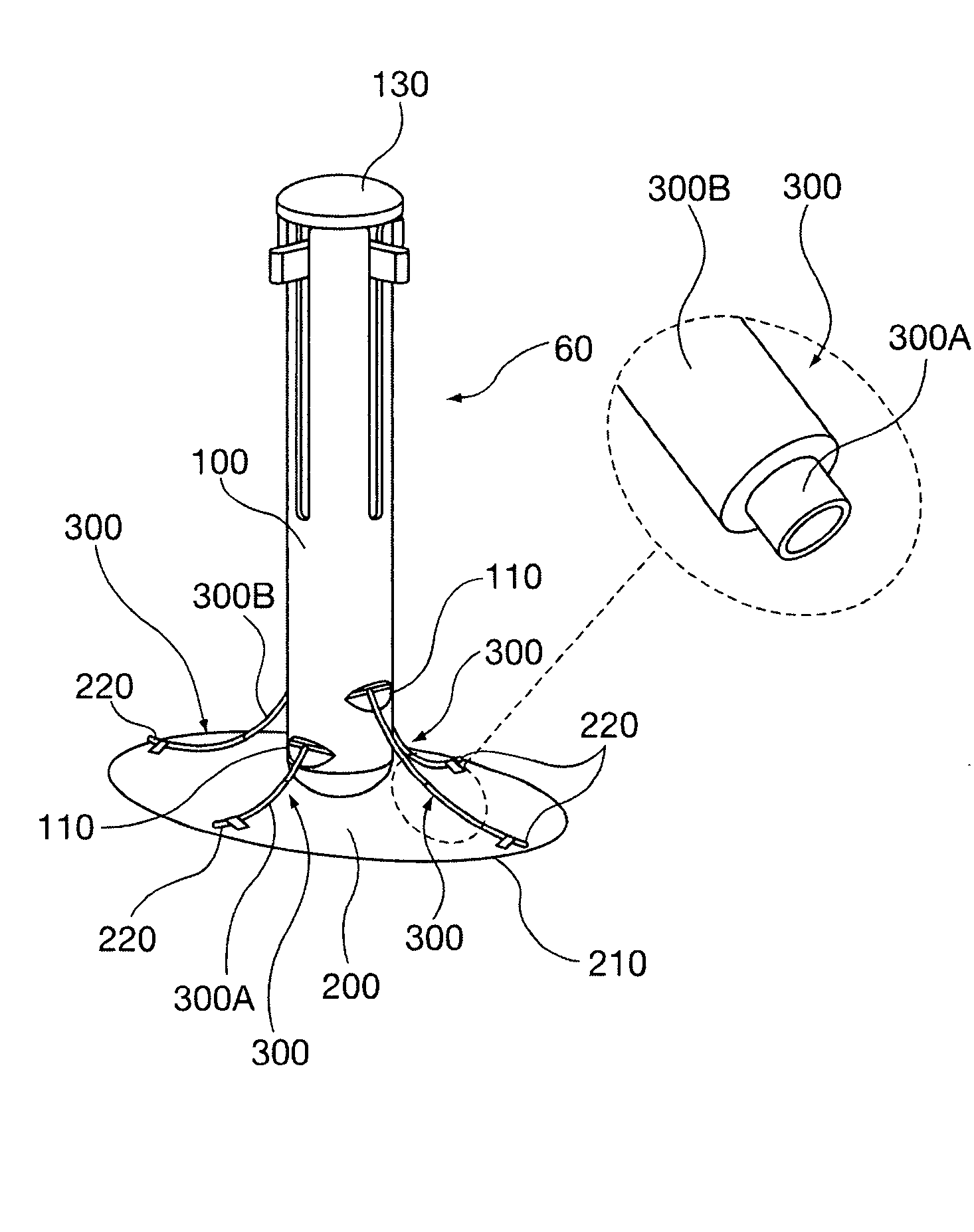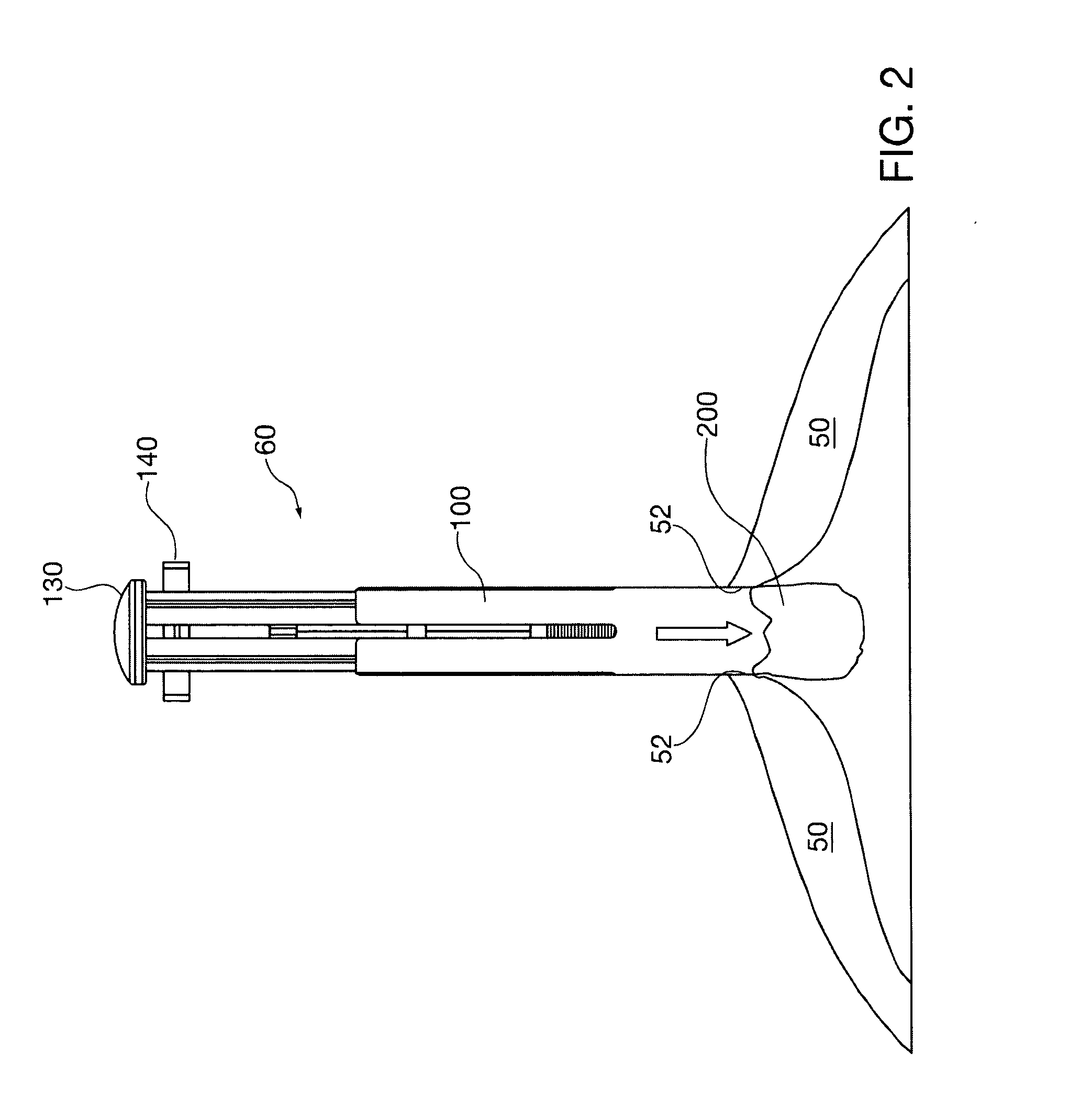Method and apparatus for minimally invasive delivery, tensioned deployment and fixation of secondary material prosthetic devices in patient body tissue, including hernia repair within the patient's herniation site
a technology of secondary material and prothesis, which is applied in the field of methods and equipment for minimally invasive delivery, tensioned deployment and fixation of secondary material, which can solve the problems of difficult to tension a planar mesh sheet across the patient, loose or flaccid mesh may not provide sufficient structural integrity, and the pliable body tissue does not always establish tension, so as to reduce the likelihood of future exfiltration
- Summary
- Abstract
- Description
- Claims
- Application Information
AI Technical Summary
Benefits of technology
Problems solved by technology
Method used
Image
Examples
first embodiment
[0046]FIGS. 1A and 1B show the repair instrument 60 of the present invention. The instrument 60 has an outer tubular device body 100, preferably with a distal rounded end 102 for insertion into an incision formed at the hernia site, to be discussed below in connection with operational descriptions for use of the instrument. Near the distal end 102 the device body 100 defines two opposing pairs of ports 110 in its outer periphery, oriented radially every 90 degrees. The ports might be staggered axially, for example to accommodate different shapes and dimensions of mesh. The device body 100 also defines four needle advancement channels 120 that are in axial peripheral alignment with a corresponding port 110. It is envisioned that the device body 100 and other delivery cannulae described herein preferably will have an outer diameter of between 0.5 inch (approximately 12 mm) and 2 inches (approximately 50 mm).
[0047]A plunger 130 is slidably received within the device body 100. The plung...
embodiment 70
[0058]FIGS. 9-15 show a constant radius needle is instrumentation embodiment 70. This embodiment utilizes a cannula port 160 with insertion depth stop 161. The cannula port 160 has an inner bore that defines needle tracks 162 having a curvature radius and diameter adapted for receipt and guidance of constant radius cannulae 330, oriented at 90 degree circumferential positions. The cannula port 160 retains pre-deployment configuration repair mesh 200, shown schematically in FIG. 9. The mesh sutures 450 respectively are threaded into one of the corresponding constant radius cannulae 330. As was described with respect to prior embodiments, the distal end of each suture 450 is affixed to the mesh 200 circumference and the proximal end is coupled to a needle. In this embodiment constant radius needles 430 are utilized, having a profile conforming to the constant radius cannulae 330.
[0059]For illustrative purposes, two mesh deployment and primary fixation site alignment apparatus and meth...
embodiment 530
[0075]Another primary fixation fastener expanding braid anchor 540 is shown in FIGS. 38-39A. The general functional concepts of a radially outwardly bowed fastener and delivery instrument 536 that were employed in the anchor embodiment 530 of the immediately prior drawing descriptions are applicable to the braid anchor embodiment.
[0076]As described in connection with other fixation fastener embodiments, a needle and sutures 450 are advanced through the patient's abdominal tissue. The delivery instrument (not shown) captures braid fastener 540 between the front and compression collars.
[0077]Braid fastener 540 has a pair of braid tubes 542 that axially sandwich a length of coreless braided cable 544 between them. The braided cable 544 may be constructed of a polymer such as polyester or polypropylene. Relative compression of the pair of braid tubes 542 with the delivery instrument 536 in the manner described with respect to the expanding anchor fastener 530 radially bows out the braid...
PUM
 Login to View More
Login to View More Abstract
Description
Claims
Application Information
 Login to View More
Login to View More - R&D
- Intellectual Property
- Life Sciences
- Materials
- Tech Scout
- Unparalleled Data Quality
- Higher Quality Content
- 60% Fewer Hallucinations
Browse by: Latest US Patents, China's latest patents, Technical Efficacy Thesaurus, Application Domain, Technology Topic, Popular Technical Reports.
© 2025 PatSnap. All rights reserved.Legal|Privacy policy|Modern Slavery Act Transparency Statement|Sitemap|About US| Contact US: help@patsnap.com



